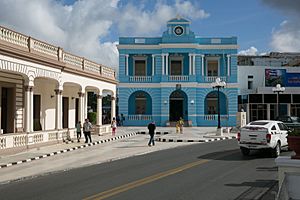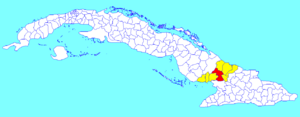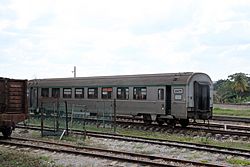Las Tunas (city) facts for kids
Quick facts for kids
Las Tunas
Victoria de Las Tunas
|
||
|---|---|---|

Las Tunas
|
||
|
||

Las Tunas municipality (red) within
Las Tunas Province (yellow) and Cuba |
||
| Country | Cuba | |
| Province | Las Tunas | |
| Established | 1759 | |
| Area | ||
| • Total | 891 km2 (344 sq mi) | |
| Elevation | 92 m (302 ft) | |
| Population
(2022)
|
||
| • Total | 214,939 | |
| • Density | 241.23/km2 (624.8/sq mi) | |
| Demonym(s) | Tunero/a | |
| Time zone | UTC−5 (EST) | |
| Postal code |
75100-75500
|
|
| Area code(s) | +53 31 | |
Las Tunas is an exciting city and a special area called a municipality in central-eastern Cuba. It is the main city of the Las Tunas Province. For a long time, from 1869 to 1976, it was known as Victoria de Las Tunas.
Contents
Where is Las Tunas?
Las Tunas is located right on Cuba's main highway, the Carretera Central. It sits between the cities of Camagüey, Holguín, and Bayamo.
City Layout and Divisions
In 1943, the municipality was split into different neighborhoods called barrios. Some of these included Primero, Segundo, and Antonio Machado. Today, the city is further divided into smaller sections known as repartos. These include areas like Primero (which is the city center), La Victoria, and Aurora.
A Look at Las Tunas History
The city of Las Tunas was first started in 1796. It grew up around a church called the Parish of San Jerónimo.
Becoming a City
In 1853, a special rule from the government officially gave Las Tunas the title of "city." This was an important step for its growth.
Capital of a New Province
Later, in 1976, a big change happened in Cuba. The large Oriente Province was divided into smaller ones. Las Tunas then became the capital of its very own new province, also named Las Tunas.
People of Las Tunas
In 2022, the municipality of Las Tunas had a population of 214,939 people. The total area of the municipality is about 891 square kilometers (344 square miles). This means there are about 240 people living in each square kilometer. People from Las Tunas are called "Tunero" (for a boy or man) or "Tunera" (for a girl or woman).
Las Tunas Climate
Las Tunas has a tropical savannah climate. This means it's hot during the day all year round. The nights are usually mild to warm.
| Climate data for Victoria de las Tunas, Cuba | |||||||||||||
|---|---|---|---|---|---|---|---|---|---|---|---|---|---|
| Month | Jan | Feb | Mar | Apr | May | Jun | Jul | Aug | Sep | Oct | Nov | Dec | Year |
| Mean daily maximum °C (°F) | 28 (82) |
29 (84) |
30 (86) |
31 (88) |
31 (88) |
32 (90) |
33 (91) |
33 (91) |
32 (90) |
31 (88) |
29 (84) |
28 (82) |
31 (87) |
| Mean daily minimum °C (°F) | 19 (66) |
19 (66) |
20 (68) |
21 (70) |
22 (72) |
23 (73) |
24 (75) |
24 (75) |
23 (73) |
23 (73) |
21 (70) |
20 (68) |
22 (71) |
Getting Around Las Tunas
Las Tunas has good ways to travel.
Train Travel
The city has a railway station. This station is on the main train line that connects Havana to Santiago de Cuba. There's also a smaller line that goes to Manatí.
Roads and Airport
A major highway, the A1 motorway, is planned to extend through the city. This highway will eventually cover the entire island. Las Tunas also has its own airport, called Hermanos Ameijeiras. It is located in the northern part of the city.
Exploring Las Tunas: Tourism
Las Tunas is known in Cuba as the "City of Sculpture." This is because you can find many cool art sculptures all around the city center.
Hotels and Future Plans
Even though it's one of the less visited provinces in Cuba, Las Tunas has two international hotels. These are Hotel Las Tunas and Hotel Cadillac. There are also many smaller bed and breakfast places for visitors. The local and national governments are working to bring more tourists to the area. For example, they are trying to attract companies to build big hotels at the beautiful Covarrubia beach.
Sports in Las Tunas
Sports are very popular in Las Tunas.
Baseball and Football
The city's baseball team is called Las Tunas. Their nickname is Leñadores, which means "Lumberjacks." They play their home games at the Julio Antonio Mella Stadium. For football (soccer) fans, the local club is the FC Las Tunas. They play at the Ovidio Torres Stadium.
Famous People from Las Tunas
- Yaquelín Abdalá (born 1968), a talented visual artist.
- Yordan Álvarez (born 1997), a professional baseball player in Major League Baseball. He used to play for the Leñadores team.
- Vicente García González (1833–1886), a general who fought in the Cuban Ten Years' War.
Sister Cities
Las Tunas has a special connection with another city:
 Arroyo Seco in Querétaro, Mexico.
Arroyo Seco in Querétaro, Mexico.
See also
 In Spanish: Las Tunas (ciudad) para niños
In Spanish: Las Tunas (ciudad) para niños



